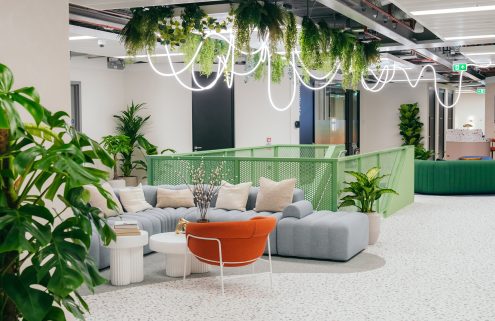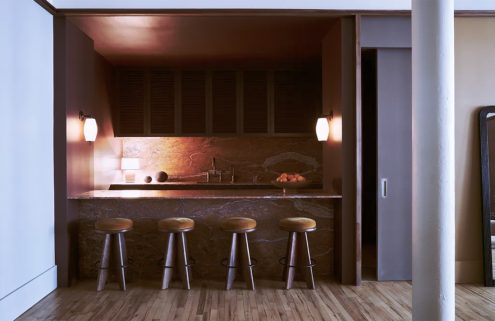As people start to think about returning to the office in some form or another, what should that space look like now? ‘Remote work is better, cheaper and healthier than bad office space,’ believes Raphael Gielgen, head of research and trend scouting at Swiss furniture company Vitra, which has released a series of E-papers on this topic. ‘Companies that keep their physical offices will need to make them an attractive place to be,’ he adds.
Along with being attractive, they must also comply with new health and safety mores – a conundrum which is taxing workplace and furniture designers.
The death of open-plan design?

The new standards don’t necessarily spell the death of open plan, according to architects Woods Bagot. They propose grouping employees in small ‘team communities.’
‘Anchoring teams to studio-sized neighbourhoods within a larger office minimizes exposure to people,’ says global workplace design leader, Amanda Stanaway.

In this new era, mobile partition systems will come into their own. One such design is Stephan Hūrlemann’s Dancing Office for Vitra. Its central feature, the Dancing Wall, can create work environments with visual and acoustic privacy and serve as a presentation surface or vegetation wall.
Reducing shared areas and surfaces is seen as key for the future. And yet those features were coworking spaces’ raison d’ être. ‘I think that shared, social spaces found in many coworking environments will shrink, and their private offices will expand,’ says Greg Keffer, partner at Rockwell Group, which designed the clubby workspace NeueHouse in New York and Hollywood.

Such changes could be constantly updated by tech, which would monitor social distancing and how people use spaces, he adds. It will be a case of preserving the DNA of coworking spaces while modifying them to exude comfort, security and safety.
Shared surfaces need to be reconsidered, says Dutch designer Hella Jongerius in Vitra’s third E-paper. ‘How to infuse materials with a tactile, human connection, and also make sure they suggest a clean, hygienic feel?’ she asks. Her suggestion: to focus on craft processes, honesty in production and maintenance.
Flexible leases and part-time spaces

But it’s not just individuals’ behaviour that will change. Helen Arvanitakis, director of Design District (the soon-to-launch creative quarter on London’s Greenwich Peninsula), argues that many businesses might not be able to return to full-time office leasing when restrictions lift, while others might not need to.
Arvanitakis’ solution is the ‘On/Off office’ where creative companies of all sizes can lease workspaces for one to three days a week. The design and layout will be flexible enough to be changed for each tenants’ specific requirements before they arrive, ‘so it truly feels like their own permanent workspace – only without the hassle or commitment of maintaining one, and at a fraction of the cost,’ Arvanitakis claims.
How this will affect Design District’s rental income remains to be seen, however.
Office furniture at a domestic scale

And what about those people who continue to spend all or much of their time working from home? Luke Pearson of furniture designers Pearson Lloyd is unconvinced that many domestic set-ups are viable long-term.
‘As we sit for longer and longer on an old plywood chair and a wobbly table that’s too small, we begin to realise eight hours at home soon requires equivalent tools to the modern office,’ such as a printer, a layout space, a space to brainstorm and stand back, and somewhere to file the unfinished documents.
But most office equipment doesn’t work at home. ‘The modern office chair is both too big and visually rather technical for the home office,’ he adds.
Jongerius’ proposal: ‘We need new furniture typologies or ways of dividing space flexibly.’ Making WFH work, then, is the next major challenge for designers.
We’ll be keeping our eyes peeled for the best innovations and adaptations over the coming months.























